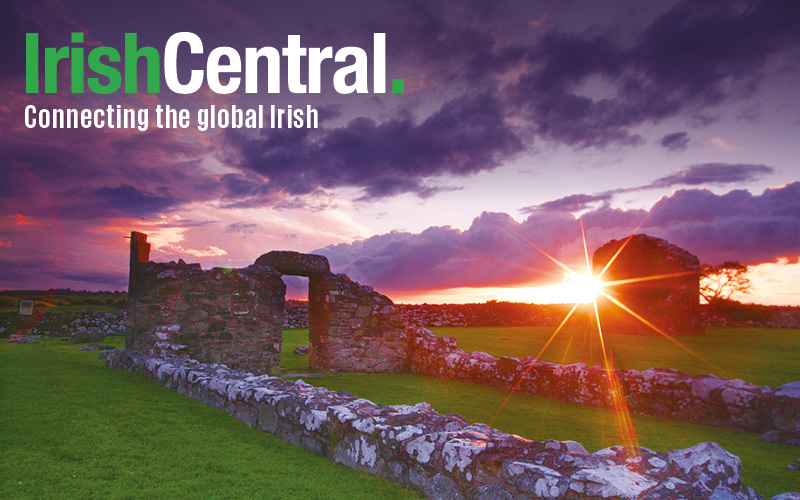Yesterday we brought you stories from the New Orleans International Irish Famine Commemoration about people who stood out and blazed trails in the early history of the Irish in New Orleans, from Spanish governor Alejandro O’Reilly to Margaret Haughery, beloved guardian of the city’s orphans.
But when did the Crescent City develop a larger Irish identity? What sort of community did the Irish famine emigrants find when they arrived in New Orleans?
A holiday, a militia and a church
Historians, as Dr. Laura Kelley explained on her tour of Irish New Orleans, use three markers to pinpoint the transition from people who happen to be of a certain culture all living in one place to a real ethnic community. They are: an organized celebration of a holiday or saint’s day, a militia, and a church.
The first public mention Kelley found of a St. Patrick’s Day celebration in New Orleans is in a newspaper from 1806 – three years earlier than previously thought. A March 1806 edition of the "Orleans Gazette" reported on a dinner hosted by “the Irish Gentlemen of the city” and included a list of 17 St. Patrick’s Day toasts the gentlemen raised their glasses to, such as:
“The memory of Gen. Washington,”
“The armies that fight for the independence of their country,”
“The Irish Shamrock – may it find a congenial soil in the plains of Louisiana,”
“The Territory of Orleans – may its inhabitants soon enjoy all the privileges of US citizens,” and
“The Fair of Louisiana – may the sons of St. Patrick ever deserve and be blessed with their smiles.”
In the final battle of the War of 1812, The Battle of Orleans, the city’s Irish formed their own local militias, such as The Republican Greens, and fought with Andrew Jackson (the son of Irish immigrants) against the British forces.
“’The Republican Greens.’ What does that tell you about the Irish people coming here?” Kelley asked. “This is a politicized group that is for a free and independent Ireland.”
And of course there were the churches. Despite its largely Catholic population, from the founding of New Orleans in 1718 until the 1830s, the city had only one Catholic church, St. Louis Cathedral. By this point, Kelley writes in “The Irish in New Orleans,” “a large enough community of Irish existed in the city to be able to demand from the diocese an English-speaking church to cater to its members.”
That’s how St. Patrick’s Church, the second Catholic church in New Orleans, came about. Beset by financial and structural troubles for the first few years of its existence, St. Patrick’s was eventually saved by benefactors from the community and by Irish architect James Gallier (Gallagher).
St. Patrick’s and St. Joseph’s, another Irish Catholic church in a less affluent area, were already in place when the Irish famine immigrants arrived in New Orleans. So too were the trappings of an Irish community that would soon grow rapidly in size and scope.
The famine Irish
It’s estimated that during the famine of 1845 to 1852, a quarter of a million Irish arrived in the US via New Orleans, and that as many as 38,000 of these emigrants remained in the city – a great enough number to make the Irish the largest immigrant group by 1850 and one sixth of New Orleans’ population by 1860.
As Minister Heather Humphreys noted in her keynote speech, “by the 1860s, an entire Irish community had developed near what is now known as the Garden District, including churches and schools. This community was the largest Irish constituency anywhere in the Old South.”
Nine out of ten Irish who sailed to New Orleans to escape the Great Hunger journeyed via Liverpool. It was an arduous journey – across the Irish Sea to Liverpool, then across the Atlantic (often via cargo ships), and then 100 miles down the winding Mississippi River, which, Dr. Kelley explained, often took as long to navigate as the Atlantic crossing.
Passage from Liverpool to New Orleans was not cheap, making the fact that the majority of Irish made the journey with at least one relation all the more remarkable. “The high percentage of family members traveling together is not just an indication of financial wherewithal, but also reveals the strength of family ties. Irish families, even in the face of a major catastrophe, stayed together,” Kelley writes. Once set up in New Orleans, the Irish would save wages to send money back to Ireland for their relatives’ fares.
New Orleans was different from New York and other points of entry to the US in that it had no Ellis Island, no quarantine. In the mid-1800s, diseases such as cholera and yellow fever were rampant in New Orleans, especially among immigrants. In the summer of 1853, the year of the city’s worst yellow fever outbreak, as many as one out of every five Irish immigrants died.
But there were also many triumphs. The famine Irish helped establish the Irish Channel neighborhood, which still exists today, and quickly came to dominate the dockyards. The famine emigrants built their own churches, such as St. Alphonsus in the Irish Channel, which still stands today as an arts and cultural center, and where the symposium portion of the Famine Commemoration took place.
Many Irish who fled the Famine became swept up in the American Civil War. In her keynote address at the symposium, Minister for the Arts, Heritage and the Gaeltacht Heather Humphreys took a moment to reflect upon the Irish who fought in the Civil War.
“I want to take the time as well this weekend to acknowledge, on behalf of the Irish Government, the enormous numbers of Irish emigrants who lost their lives in the American Civil War. It is estimated that between 170,000 and 200,000 Irish fought in that defining conflict of these independent United States,” she said. “The vast majority of Irish combatants – probably more than 150,000 - fought with the Union troops, with the Irish in the Confederate ranks possibly numbering 20,000.”
During and after the Civil War, New Orleans, like the entire South, changed utterly, and following the Confederate defeat and emancipation of slaves, entered a deep economic decline. As a consequence the city lost much of its appeal to immigrants. However, Kelley notes, this gave the remaining Irish community the chance to strengthen ties, branch out into new sectors and reach new levels of power. The Hibernia Bank and Trust Company was founded largely by Irish in 1870. In 1892, a man named John Fitzpatrick became New Orleans’ first Irish American mayor.
The forgotten Irish
There are the well-known Irish stories of the Civil War – those of Union General Thomas Francis Meagher and Thomas Hough, the first soldier to die. But during the Famine Commemoration Minister Humphreys said that her thoughts were more with “the tens of thousands of what have been termed the ‘forgotten Irish,’ who lost their lives or loved ones on the battle fields of this great country and whose sacrifice history has too often overlooked. Men – and women too – who in many instances fled the Famine which tore Irish society apart, only to arrive into a war which was, incredibly, of comparable suffering and heartbreak.”
As Damian Shiels, a leading historian and chronicler of the Irish who fought in the American Civil War has frequently pointed out, the stories of so many Irish who emigrated during this time have been largely forgotten.
Also largely forgotten in Irish American history are the thousands of Irish who died digging New Orleans’ New Basin Canal starting in the 1830s. The New Basin, built to rival the city’s main Carondelet Canal, was a massive undertaking – 60 feet wide and 6 miles long, later extended to 100 feet wide. Thousands of Irish toiled digging the canal, and though the actual number of deaths remains uncertain it’s believed that anywhere from 8,000 to 20,000 Irish died from cholera, malaria and other diseases spread via the worksite, many buried without ceremony.
In 1990, the Irish Cultural Society of New Orleans erected a Celtic cross memorial to the Irish who died digging the New Basin Canal, bringing their story to light. At the close of the Famine Commemoration, the City of New Orleans, the visiting Irish dignitaries and the New Orleans Ancient Order of Hibernians dedicated and blessed the opening of a new four-acre park at the site of the New Basin Canal Celtic Cross Memorial. Hibernian Memorial Park pays tribute to the canal workers and to the larger Irish legacy in New Orleans.
Followed by a visit to the former site of the New Basin Canal to open the new Hibernian Memorial Park pic.twitter.com/3t559fRsyG
— Heather Humphreys (@HHumphreysFG) November 9, 2014
Irish NOLA today
The Irish Channel, though no longer predominantly Irish, is still the center of Irish culture and activities and the starting point of the St. Patrick’s Day parade each year. As one might expect from a city known for its parades, the New Orleans St. Patrick’s Day parade is a joyous, colorful affair. Instead of just the beads thrown on Mardi Gras, parade-goers throw cabbages, onions, carrots and potatoes, which people take home to make soup.
There are thriving Irish organizations in New Orleans, from the Ancient Order of Hibernians to the Irish Cultural Society of New Orleans, from Irish dance schools and the festivals to the Irish Network New Orleans, which worked to organize the Famine Commemoration.
And of course there’s the food. The Brennan restaurant legacy, started in 1946 when Owen Brennan opened his first Brennan’s restaurant – allegedly to prove to a naysayer that an Irishman could run a restaurant just as well as anyone else – continues today with 14 restaurants in New Orleans and the original Brennan’s set to re-open soon. Stop by the Irish House, owned by “Chopped” winning chef Matt Murphy, originally from Dublin, or Fin McCool’s pub in the Irish Channel, owned by Pauline and Stephen Patterson from Belfast.
Many Irish in New Orleans are following in the footsteps of Margaret Haughery’s great compassion and generosity. There’s Stewart Young, the Belfast-born program director of Café Reconcile, which trains at-risk youths from New Orleans’ low income communities in food preparation and hospitality skills, setting them up with placements in the city’s extensive restaurant industry. There’s Sister Vera Butler of Lantern Light Ministries pantry and food kitchen, which feeds the homeless and the poor.
Irish fighting poverty in New Orleans today: Stewart Young @CafeReconcile pic.twitter.com/lRxzW35EGe
— CG Ireland Atlanta (@IrelandAtlanta) November 6, 2014
Nine years since the devastation of Hurricane Katrina which flooded 80% of the city and claimed the lives of 1,200, New Orleans continues to rebuild itself anew.
As Minister Humpheys noted in her keynote address, “The Famine was characterized by suffering, sacrifice and survival, experiences the people of New Orleans know only too well… But like the survivors of the famine, the people here have shown strength beyond belief and the thriving city of New Orleans today is a testament to that spirit of resilience.”
The Irish in New Orleans are proud of this spirit – proud of the resilience of their ancestors and of their city. The Famine Commemoration gave them a chance to revel in that pride and to share their history fully – both the well-known parts and the forgotten or neglected stories that deserve to be told and known.
Here’s looking forward to the many other neglected Irish stories the International Famine Commemoration might bring to light in years to come.
Do you think your city has an important story to tell of Irish Famine emigration and beyond? Let us know in the comment section, and click here to read more about the official Famine Commemoration.




Comments